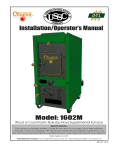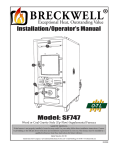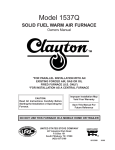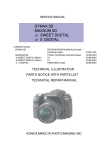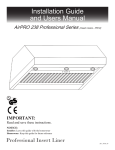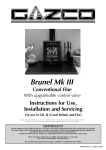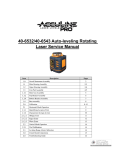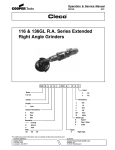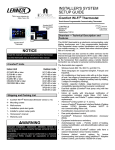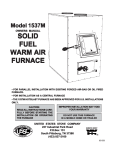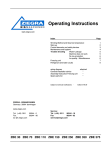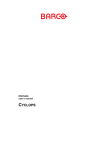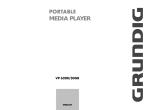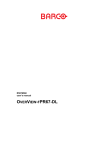Download United States Stove 1600M Furnace User Manual
Transcript
UNITED S TATES ST STOVE C OMP ANY COMP OMPANY K ee ping North America W arm eeping Since 1869 MODEL: 1600M WOOD and COAL FURNACE SAFETY NOTICE: IF THIS FURNACE IS NOT PROPERLY INSTALLED, A HOUSE FIRE MAY RESULT. FOR YOUR SAFETY, FOLLOW THE INSTALLATION DIRECTIONS. CONTACT LOCAL BUILDING OR FIRE OFFICIALS ABOUT RESTRICTIONS AND INSTALLATION REQUIREMENTS IN YOUR AREA. REFER TO MARKINGS ON APPLIANCE FOR ADDITIONAL INFORMATION. Installation/Operator's Manual #851547A 1 INTRODUCTION CLEARANCES Thank you for your purchase of a U.S. Stove Wood and Coal burning furnace. Your decision to buy our Clayton Furnace was undoubtedly reached after much careful thought and consideration. We are very proud you chose the U.S. Stove furnace and trust you will receive the comfort and economy that others realize when heating with a U.S. Stove product. Your dealer is important in your experience with the Furnace not only in your purchase, but in his recommendations for professional installation in your home. The qualified professional installer (as recommended by your dealer) has been expertly trained in solid-fuel furnace installation to assure the safety and comfort for your family while saving you money. Trust your experienced installer. He is a specialist in his field. FLAMMABLE WALL 20" 15" (TOP VIEW) 22" FLUE 12" IMPORTANT Before installing and using your Clayton Furnace, please read the following pages thoroughly and carefully. If you follow the instructions, your Clayton furnace will give you safe and more dependable service in the years to come. MINIMUM CLEARANCE TO FLAMMABLE WALLS CAUTION: Do not store combustible or flammable material near furnace. REDUCED CLEARANCES NFPA guidelines and most codes permit reduced clearances to combustible walls and ceilings if adequate protection is added. A common mistake is to assume that sheet metal, masonry, or millboard placed directly against a wall protects it. Materials installed in this manner give very little protection. These materials are good heat conductors, so they will be almost as hot on their back side as they are on the exposed side. Therefore, the combustible wall behind is still a fire hazard. A wall can be kept cool using these items but only if they're mounted and spaced out from the wall by an inch or two to allow free circulation of room air behind the protective panel. The protective panel should start within a few inches of floor level. The three rules to follow when constructing wall protectors: 1. Non-combustibility of all materials including mounting or supporting. 2. A well ventilated air space between protector or wall. 3. Sufficient strength and rigidity so that the protector and air space will be durable. First step; check your local codes. This installation must comply with their rulings. Do not install this furnace in a mobile home or trailer. Always have a smoke or ionization detector and a CO detector installed in your home. To prevent injury or damage, do not allow anyone who is unfamiliar with the furnace to operate it. Spend some time with your furnace to become well acquainted with different settings and how each will affect its burning patterns. It is impossible to state just how each setting will affect your furnace because of the variations in each installation. DISCLAIMER NOTICE The BTU ranges and heating capacity specifications are provided as a guide only and in no way guarantee the output or capacity of the units. The actual BTU output depends on the type of fuel being burned and its conditions, the thermostat setting, the draft adjustment and the chimney to which the unit is attached. The actual area that the unit will heat depends on factors such as the conditions of the building, heat loss, type of construction, amount of insulation, type of air movement, and the location of the unit, and more importantly, your duct work and return air facility. 2" FROM CEILING CONSTRUCTING NON-FLAMMABLE WALLS WARNING: Do not alter this appliance in any way. Doing so may void your warranty. PROTECTIVE COVERING AND ALL SUPPORTS MUST BE NON-COMBUSTIBLE. 1" AIR SPACE These instructions comply with CAN/CSA-B365 2" FROM FLOOR LOCATING YOUR FURNACE CHIMNEY REQUIREMENTS The furnace is to be installed maintaining clearances as shown in illustration. Do not place the furnace directly on a combustible floor. If you're placing it on a combustible floor, an approved fire retardant material equivalent to 3/8" UL Listed millboard should be placed under the furnace. The material must extend at least 16" in front of and 8" on either side of the fuel-loading and ash-removal doors, and underneath the chimney connector and extending at least 2" on either side of the chimney connector. A fireclay lined masonry or Class A 103HT All-Fuel Metal Insulated Chimney must be used in all airtight wood furnace installations. The minimum recommended flue size for the U.S. Stove Clayton Furnace is 6" (inside diameter) for round flues, and 7" x 7" for square flues. When making new chimney installations, always follow the chimney manufacturers instructions. 2 NOTE: Type of chimney: Class A All-Fuel UL 103HT TOP OF CHIMNEY MUST BE 2 FT. ABOVE HIGHEST POINT OF ROOF WITHIN 10 FEET on the flue lining. When ignited, this creosote makes an extremely hot fire. The chimney connector and chimney should be inspected at least twice monthly during the heating season to determine if a creosote build-up has occurred. If creosote has accumulated, it should be removed to reduce the risk of a chimney fire. CAP SHOULD HELP PREVENT DOWNDRAFT WHILE STILL PROVIDING ADEQUATE EXHAUST. SMOKE PIPE INSTALLATION 2 FT. MINIMUMS 3 FT. MINIMUM MINIMAL 3 FT. FROM TOP OF CHIMNEY TO POINT AT WHICH IT PASSES THROUGH THE ROOF. CHIMNEY FLUE SHOULD BE CONSTANT DIAMETER THROUGHOUT ITS ENTIRE HEIGHT. APPROVED CHIMNEY Clearances to combustible materials (i.e. paneling, ceiling tile, sheet rock, plaster, draperies, casements or wood trim, etc.) will vary with the type of flue connection used. Be sure to maintain the specified clearances for your type of installation. TYPE OF FLUE REQUIRED CONNECTION CLEARANCE 24 Gauge or Heavier 18" Single Wall Stainless Steel or Black Pipe Double Wall Stainless Steel 6" RECOMMENDED MINIMAL 20 FT. HEIGHT CHIMNEY FLUE MUST BE AS LARGE OR 20% LARGER THAN FURNACE FLUE PIPE Class A 103HT All-Fuel or Equivalent 2" COMBUSTIBLES SMOKE PIPE CLEANOUT DOOR SHOULD HAVE AIRTIGHT FIT. DO NOT LEAVE OPEN WHEN FURNACE IS IN OPERATION. CHIMNEY THIMBLE SHOULD BE CONSTRUCTED OF FIRE CLAY, AND SHOULD FIT TIGHTLY TO FLUE PIPE. According to NFPA standards, single wall stove pipes can be within 9" of combustibles provided an approved fire retardant material covered with 28 gauge sheet metal, spaced out 1" on non-combustible spacers, is utilized. See illustration. 1. The furnace should be the only heating appliance using a chimney flue. One furnace per flue. 2. A masonry chimney should have a tile or stainless steel liner. 3. The masonry chimney should not have any missing mortar or loose bricks. 4. There should be no mortar or parts of the chimney blocking the chimney flue. 5. There should be a two inch clearance between any chimney (masonry or metal) and combustibles (such as the house). 6. The chimney should extend at least 2' above the highest point of the house, or 2' above the point at which the chimney is 10' from the roof. 7. The chimney should be relatively straight and vertical. 8. The portion of an all-fuel metal chimney that extends above the roof should be well secured. 9. A masonry chimney should be built on footings and not attached to the house. 10. A rain cap, complete with an animal or bird screen, should be installed on top of the chimney. 18" 9" 18" CEILING OR WALL When using a Class A or double wall flue pipe connection, follow the manufacturer's instructions. When constructing a single wall smoke pipe, the following guidelines must be observed. 1. The connector pipe should be 24 gauge or heavier stainless steel or black pipe. 2. Secure all joints with three #8 screws. 3. If the connector pipe must pass through a wall, an approved insulated or ventilated thimble, at least three times the diameter of the smoke pipe must be used. (i.e. a 6" diameter smoke pipe needs an 18" thimble). CREOSOTE — FORMATION AND NEED FOR REMOVAL 4. The connector pipe should never be used as a chimney. IMPORTANT INFORMATION FOR ALL CONNECTOR PIPES When wood is burned slowly, it produces tar and other organic vapors, which combine with expelled moisture to form creosote. The creosote vapors condense in the relatively cool chimney flue of a slow-burning fire. As a result, creosote residue accumulates The connector pipe must be constructed and installed so that it 3 maintains clearances, keeps condensation and creosote within the pipe, and is capable of withstanding a two to three thousand degree chimney fire. 1. The connector pipe should slant down toward the furnace a minimum of 1/4" to the foot. At no time should the pipe turn downward toward the chimney or run horizontal. HEATED AIR DISCHARGE The Clayton furnace is designed for use as a supplemental heating source. When used as a supplementary furnace, the 1600M is connected in conjunction with an oil, gas, or electric furnace to the existing duct work which distributes the heated air into several rooms and/or areas. Though United States Stove Company expressly Does Not recommend the use of its furnaces to be installed and/or used as a free-standing heater, it is possible to achieve a reasonably safe and functional installation IF certain standard procedures are followed. The following are guidlines only and are intended to enable the furnace user to obtain resonable efficiency from his furnace, and with due respect to safety when installing as a "freestanding heater". If installed correctly, and in accordance with the instructions found in this manual, your warm air furnace may be installed as a "space heater" within living quarters, cabins, garage, or workshop. Please adhere to the following: 2. There should be no more than two 90 degree elbows. 3. The connector pipe should never be longer than six feet. If it is absolutely necessary to make a run of more than six feet (not recommended) use extra support brackets every 3 feet. 4. The connector pipe should never be reduced to a smaller size than flue opening on the furnace. 5. The connector pipe should not block the flue of the chimney or extend into it in any way. 6. A good airtight thimble should be used to hold the connector pipe in the chimney. It should be constructed so the connector pipe can be removed for cleaning. 1) The use of a cold air return and/or filter box is mandatory. This will not only inscrease your blower life and provide filtered air, it will also help prevent the blower or blowers from "capturing" heated air exiting from the top of the furnace heat outlets. 7. The connector pipe should not leave the heated portion of the building to reach the chimney. 2) If installed as purchased , without directing the heat away from the furnace itself, it will simply sit and cycle, turning the blowers off and on. The thermostat may not function properly. 8. The connector pipe should not pass from one story to the next before entering the chimney, nor should it pass through any closed or enclosed space. 3) All larger furnaces (or those with multi-speed blowers) absolutely require BACK PRESSURE to prevent premature winding failure. If allowed to operate at high RPM (As in "FREE AIR" mode - no ductwork or flow restrictions) the windings overheat, insulation melts and the motor simply burns up - not covered under warranty. 9. The connector pipe and any elbows must be of 24 ga. or greater. 10. The connector pipe should not be located near or in a walk way or well traveled area. 11. All male ends of connector pipe should run or point towards the furnace. CONNECTING HOT AIR DUCT TO FURNACE DAMPERS ON STOVE PIPES We strongly recommend that the warm air duct work be installed by a home heating specialist. If doing the installation yourself, before you decide which installation will best suit your needs, consult a qualified heating technician and follow his recommendations as to the safest and most efficient method of installation. The warm air duct must be constructed of metal with a minimum temperature rating of 250°F When you have installed the connector pipe between your furnace and the chimney, tap the pipe hard with your fingernail. Remember the sound it makes - it will be a "ting" echoing inside the stove pipe. If later you tap and hear a muffled thud, you are building up soot in the pipe and should clean it. This pipe should be cleaned at least once or twice during the heating season. The following illustrations are the only acceptable configurations when installed with existing oil or gas furnaces. DO NOT CONNECT TWO HEATERS TO THE SAME CHIMNEY FLUE. The National Fire Prevention Association recommends that woodburning appliances vent into a separate flue from gas or oil furnaces. If such an installation is contemplated, first check with a local building inspector to find out if a separate flue for a woodburner is required. INSTALLATION EXAMPLES INSTALLATION NO.1 With this installation, a back draft damper is inserted into the heat run before the plenum of the existing furnace to prevent air from the existing furnace to blow back into the furnace when it is not in use. When a back draft damper is employed, it should be located as close to the existing furnace plenum as practical. If codes allow, use extreme care in making such installations. Be sure that one pipe is higher than the other so that the two openings will not be opposite each other. Also, when connecting two heaters into the same chimney flue, the flue size should be large enough to handle both heaters. Very few codes and standards allow same flue connection. Such installations can cause severe problems. Gas hoods and barometric dampers allow excess air into the chimney causing cooling of the flue gases and a greater creosote build-up potential. If the same flue connections are used, chimneys must be inspected more frequently and the chimney should be cleaned any time the creosote deposits exceed 1/4" thickness. A creosote fire in such a chimney can burn out of control because of the air leak through the barometric damper or gas hood. Keeping the chimney clean and burning well-seasoned wood is absolutely necessary. This type of installation does require more frequent inspection and maintenance. BACK DRAFT DAMPER HOTBLAST FURNACE 4 EXISTING FURNACE INSTALLATION NO. 2 INSTALLATION NO. 3 Extending the hot air duct from the furnace into the existing plenum will help direct the flow of air from the 1600M as well as the flow in the existing furnace. Ducting entering the existing plenum at an angle (approximately 45 degrees) will facilitate air flow from the furnace while diverting air from the existing furnace. The baffle on this system should be made the full width of the furnace plenum in order to properly direct the air into the distribution ducts. BAFFLE EXISTING FURNACE HOTBLAST FURNACE HOTBLAST FURNACE EXISTING FURNACE 2" MIN. 1" MIN. 9 FEET EXISTING FURNACE (if used) 1" MIN. 9 FEET HOT AIR PLENUM HOTBLAST FURNACE HOT AIR DUCT MINIMUM CLEARANCES TO COMBUSTIBLES CAUTION: The warm air supply outlet of the supplementary furnace should not be connected to the cold-air return inlet of the central furnace because a possibility exists of components of the central furnace overheating causing it not to operate properly. RETURN AIR IS VERY IMPORTANT When installing a Clayton Furnace, return air must be incorporated into the system. Return air can be provided by installing a separate duct system or by tying into the cold air return of an existing gas or oil furnace. The cold air return duct can be connected to the furnace with either a factory manufactured U.S. Stove filter box or an equivalent fabricated from sheet metal (See pages 22-23). INCORRECT INSTALLATION NO RETURN AIR PROVIDED When installing a cold air return, the following minimum size should be maintained to insure proper furnace performance. Model 1600M — 16" x 20" or equivalent (320 sq. in.) Failure to provide return air ducts of the specified size voids the furnace warranty. HOTBLAST FURNACE EXISTING FURNACE COMBUSTION AIR A filter should be installed in the cold air return. Furnace filters should be checked and cleaned or replaced regularly. If return air is not provided, the warm air distributed into your home will be restricted and the efficiency of the furnace decreased. Without a return air system, warm air will be drawn into your basement, unnecessarily heating unused areas of the home. In extreme cases, if your basement or utility room is fairly air tight, the large blower on the 1600M could depressurize the room and pull toxic flue gases from the furnace, a gas water heater, or gas furnace. The fumes could then be distributed throughout the house. All fires need air (specifically oxygen) to burn. Furnaces, fireplaces, and wood-burning furnaces need enough oxygen for complete combustion of their fuels. The incomplete combustion that takes place when a furnace is "air starved" causes carbon monoxide (CO) to be formed in quantities that can be dangerous inside a well-sealed house. Having a source of combustion air from outside prevents this "air starvation" of the furnace. A simple positive air supply can be constructed using dryer vent and a modified termination. 5 ASSEMBLY INSTRUCTIONS Your furnace is shipped from the factory in four (2) packages. 1) the furnace, 2) the blower. The draft kit and parts box containing all parts necessary, and the fan thermodisc kit is boxed and packed in the firebox or ash pan. Before assembling the furnace, check to make sure there is no shipping damage, and that all necessary parts are located in the firebox. See parts list below. If you find shipping damage or any of the parts missing, contact the dealer immediately. He will take the necessary steps to correct the problem. BRICK INSTALLATION (PRE-INSTALLED AT FACTORY) NOTE: Prior to operation, be sure to remove brick retaining strips. MODEL 1600M - (6) BRICKS ON EACH SIDE FIREBOX LEFT SIDE Parts List All models include the following: (2) Door Handles (1) 1/4" x 1" Hex Bolt (1) Fuel Door Latch (1) 3/8" Lock Nut (1) Ash Door Latch (1) 3/8" Jam Nut (2) 1/2" Washers (2) 3/8" x 2 1/2" Carriage Bolt (9) 1/4" Kep Nuts (6) 1/4" x 3/4" Hex Bolts (2) Spin Draft (1) Smoke Door (4) Brass Coil Knobs (1) Hinge Bracket (1) Shaker Handle (2) 1/4" x 1-1/4" Carriage Bolts (2) Smoke Door Clips BRICK RETAINING STRIP SLIDE 4th BRICK BACK BEFORE INSTALLING 5th AND 6th BRICK FIREBOX: The firebrick must be inserted on each side resting on the grate frame. First, place cut brick in each back corner. Place remaining brick in place. DOOR HANDLE INSTALLATION Insert door handle into door. From rear side of door place 1/2" washer over threaded part of door handle. Then attach 1/2" lock nut, being careful not to over tighten. Handle should turn freely. FUEL & ASH DOOR LATCH INSTALLATION With two 1/4" x 3/4" hex bolts, attach the door latch to the door latch mounting bracket on the left side of door frame as illustrated. Adjust latch until door closes securely. FUEL DOOR ILLUSTRATION ASH DOOR ILLUSTRATION LOCK WASHER HEX NUTS 6 SMOKE CHAMBER (If re-assembly is necessary): 1. Place #1 firebrick in the back of smoke chamber. 2. Slide baffle plate into smoke chamber, flat side down. 3. Place remaining firebrick in smoke chamber as numbered below. (In placing the firebrick in the smoke chamber, lift the left side of firebrick first and drop into place.) See Illustra tions below. 2 (41/2) BRICKS 1 1/2 BRICK 3 5 4 6 TOP REAR OF FIREBOX THE MODEL 1600M PLENUM OPENING 13"x18" Rectangle Plenum Opening 7 SMOKE DOOR INSTALLATION DISTRIBUTION BLOWER INSTALLATION Distribution blower slides onto rear of furnace. Engage blower flange with channels and press down. SMOKE DOOR CLIPS 1/4" LOCK NUTS 1/4" X 1-1/4" CARRIAGE BOLTS FRONT OF FURNACE SHAKER GRATE HANDLE INSTALLATION 1. Attach angle with two 1/4" x 3/4" hex bolts and two 1/4" lock nuts. 2. Attach handle with 1/4" x 1" hex bolt and 1/4" lock nut. 3. Put brass knob onto end of handle. SMOKE DOOR FUEL LOADING DOOR FRAME 1 INSTALLING ASH DOOR SPIN DRAFT 1. Screw spin draft onto 3/8" x 2-1/2" carriage bolt. 2. Screw spin draft and bolt assembly into ash door allowing approximately 1/2" of the bolt to extend beyond the inside of the door. 3. Secure bolt in place with 3/8-16" locking nut. 2 SPIN DRAFT CAP 3/8-16 x 2-1/2" CARRIAGE BOLT 3 3/8-16" LOCK NUT 8 ELECTRICAL INSTALLATION ALL WIRING MUST BE DONE BY A QUALIFIED ELECTRICIAN Predrilled holes are provided on the back of the furnace for mounting the electrical box. 9 ALL WIRING MUST BE DONE BY A QUALIFIED ELECTRICIAN 10 TESTING AND OPERATING PROCEDURES TESTING: 5. Close the spin draft cap on ash door. 6. The motorized natural draft cycles on demand from the U.S. Stove wall thermostat. Setting the thermostat four degrees higher that your existing thermostat is recommended. During operation, the motorized natural draft remains open until the thermostat temperature setting is reached. 1. Check the draft blower (optional) by turning the room thermostat up high enough so that the draft blower turns on. Then ower the thermostat setting until you hear it shut off. 2. Use a sheet of newspaper to test your draft by placing it inside the furnace and lighting it. With completion of the tests above, you are ready to light the furnace. Follow the operating steps. CAUTION: Hot Surfaces. Keep children away. Do not touch while in operation. STARTING A WOOD FIRE Using Forced Air Draft (optional) CAUTION: Cleaning of the heat exchanger, flue pipe, chimney and draft inducer, if used, is especially important at the end of the heating season to minimize corrosion during the summer months caused by accumulated ash. Shut off FAD when fuel door is open. CAUTION: Never use gasoline, gasoline-type lantern fuel, kerosene, charcoal lighter fluid, or similar liquids to start or "freshen up" a fire in the furnace. Keep all such liquids well away from the furnace while it is in use. 1. Open spin draft cap on ash door. 2. Pull the slide baffle rod to the front position. 3. Open the fuel load door and light fire using kindling and several sheets of newspaper, then close the furnace door. The furnace door should remain closed for 5 to 10 minutes in order to establish the fire. If the fire has established, you are ready to load the furnace. CAUTION: To prevent flame and smoke spillage, the slide baffle must be pulled out and the fuel door must be cracked for ten seconds before being fully opened. Do not over fire your furnace! After you have become familiar with its operating, you should know how much wood to use. 4. Load the furnace, close the load door and push the slide Baffle rod to rear. 5. Close the spin draft cap on ash door. 6. The forced air draft cycles on demand from the wall thermostat. Setting the U.S. Stove thermostat four degrees higher than your existing thermostat is recommended. In operation, the power draft blower will run until the U.S. Stove thermostat temperature setting is reached. The draft regulator on the forced air draft is preset at the factory and should require no adjustment. CAUTION: Do not use chemicals or fluids to start the fire. CAUTION: To avoid excessive temperatures, do not operate with fuel door or ash pan open. STARTING A COAL FIRE If you burn coal a Forced Air Draft may be required. Shut off FAD when fuel door is open. Open smoke pipe damper all the way. Open all draft controls on your furnace. Pull the slide baffle forward. Place about 10-15 lbs. of coal in on the shaker grates. It should come up to about half of the first firebrick level. Place crumpled paper over the coal and criss-cross a couple handfuls of dry kindling wood 3/4" in thickness on top of paper. Ignite the paper and close loading door. Wait about 30 minutes until coal fire is established before adding more coal. NOTE: NEVER load coal over the level of firebrick. Close by-pass damper and set all draft controls to your own needs. It may take 3 to 4 coal fires to determine how your local coal and the Hotblast Furnace reacts together-adjusts drafts accordingly. Loading with a good bed of coals in the morning-open by-pass damper. 1. In normal shaking, only rock the grates a small amount to sift ash through. 2. Remove all ashes every day from ash pit. 3. With your poker, push hot burning embers to the rear of the unit and add green coal in front. NEVER load over height of firebrick. This can result in damage to your furnace and home. 4. Close by-pass damper. Too much draft air will cause clinkering of coal and will waste heat up the chimney. Shut draft down to as low a point as you can and still heat your home. 1. NOTE: Never stand in front of loading door when opening it. Stand to the side. 2. NEVER completely cover the live fire with fresh coal. Always leave a generous area of glowing coal at the top of the fire and at the rear. STARTING A WOOD FIRE Using Manaul Natural Draft Shut off FAD when fuel door is open. CAUTION: Never use gasoline, gasoline-type lantern fuel, kerosene, charcoal lighter fluid, or similar liquids to start or "freshen up" a fire in the furnace. Keep all such liquids well away from the furnace while it is in use. 1. Turn up thermostat to open manual damper. 2. Open spin draft cap on ash door. 3. Pull the slide baffle rod to the front position. 4. Open the fuel load door and light fire using kindling and several sheets of newspaper, then close the furnace door. The furnace door should remain closed for 5 to 10 minutes in order to establish the fire. If the fire has established, you are ready to load the furnace. CAUTION: To prevent flame and smoke spillage, the slide baffle must be pulled out and the fuel door must be cracked for ten seconds before being fully opened. Do not over fire your furnace! After you have become familiar with its operation, you should know how much wood to use. 4. Load the furnace, close the load door and push the slide baffle rod to rear. 3. Always keep the ash pit clean. 11 Do not store fuel or other combustible material within marked installation clearances. OPERATING NOTES Do not over draft the furnace! It is designed to operate at .06 inches of water column and must be set with a draft gauge to maintain a steady draft. (Barometric Damper recommended.) Disposal of Ashes - Ashes should be placed in a metal container with a tight fitting lid. The closed container of ashes should be placed on a non-combustible floor or on the ground, well away from all combustible materials, pending final disposal. If the ashes are disposed of by burial in soil or otherwise locally dispersed, they should be retained in the closed container until all cinders have thoroughly cooled outside. Do not allow ashes to build up higher than 2" above grates. Be extremely careful when removing furnace ash pan; it can get very hot. With new steel, there is a small amount of oil or dirt on the metal. You may smell an odor. This is normal during the first operation. You may want to assemble the furnace out of doors and build a small fire in it to "burn off" this dirt and oil before installing the unit. NOTE: For further information on using your furnace safely, obtain a copy of the National Fire Protection Association publication "Using Coal and Wood Stoves Safely." NFPA NO. NW-81974. The address of the NFPA is 470 Atlantic Ave., Boston, Massachusetts 02210. The furnace is designed to burn air dried wood at a predetermined firing rate. Over firing could result in damage to the heat exchanger and cause dangerous operation. Over firing occurs when the ash door is left open during operation or a highly volatile fuel, i.e. large amounts of small kindling, is used. THIS IS A WOOD AND COAL BURNING FURNACE AND SHOULD NOT BE ALTERED IN ANY WAY! When tending the firebox always pull the baffle slide rod out prior to opening load door. Open load door slowly to avoid a "flash back". After closing load door, push the baffle slide rod to the rear. Equip your home with fire extinguishers and smoke detectors appropriately located. Canadian Requirments for Supplementary (add-on) furnaces. Inspect air filters regularly. The air filter in the filter box should be changed at least every 30 days. Oil motor on forced air draft every 90 days with a few drops of 30 wt. oil. Do not use duct elbows having an inside radius of less than 6 in. (150mm) on the (oil, electric, gas) furnaces. On electric furnaces, Do not connect to a down flow furnace. The distribution blower motor may be one of two types. If the motor has sealed bearings, no oiling is required. Do not connect ductwork so that a reverse flow is possible. If the motor is equipped with fill holes, the motor should be oiled every 90 days with several drops of 30 wt. oil. Operate the (oil, electric, gas) furnace periodically to ensure that it will operate satisfactorly when needed. Check the fit on the load door. It must fit tightly. If it does not, check for deterioration or wear of the ceramic rope seal. Replace defective seals. Do not relocate or bypass any of the safety controls in the original (oil, electri, gas) furnace installation. Inspect and clean your chimney and stove pipe regularly. Do not connect to any gas furnacethat has not been certified initiallyas complying with CAN/CGA-2.3 In event of chimney fire, shut all draft controls and call your fire department immediately. Alert everyone in the house. If the fire is still burning vigorously, throw baking soda into firebox or discharge a fire extinguisher into the firebox. After chimney fire is over, completely inspect system for damage before further use. The operation of the gas furnace must be verified for accept able operation before and after installation of the add-on appliance by a gas fitter who is reconized by the regulatory authority. Do not connect to any gas furnace that is not equipped with an air-circulation blower, or to a chimney or vent serving a gas furnace or gas appliance. Slow fires: It is not recommended burning the Clayton furnace any more than necessary early in the fall and late spring, as you cannot keep the firebox hot enough (without overheating your home) to burn gases. Slow fires can cause excessive creosote build-up in smoke pipe, chimney and firebox. This Add-On Supplymentary Furnace should only be installed on a furnace duct system and chimney that are in good operating condition. Wood should be placed directly onto the cast iron grate of the Clayton furnace. Do not use additional grates and/or irons. In the event of a power failure, you may operate the 1600M furnace provided the following instructions are followed: Outside Combustion air may be necessary if: 1. The solid-fueled fired appliance does not draw steadily, smell, experiences smoke roll-out, burn poorly, or back drafts whether or not there is combustion present. 2. Any of the above syptoms are all eviated by opening a window slightly on a calm day. 3. The house is equipped with a well-sealed vapor barrier and tight fitting windows and/or has powered devices which exhaust house air. 4. There is excessive condensation on the windows in the winter. 5. A ventilation system is installed in the house. 1. Any air filter should be removed. 2. If the motorized natural draft is used, the draft cap is to be set at a 1/2 inch opening. If the forced air draft is used, the damper on the built-in draft regulator will automatically open to the preset factory spacing. Do not burn garbage, plastics, gasoline, drain oil or other flammable liquids. Plastics, when burned, form hydrofluoric and hydrochloric acids which will damage and destroy your furnace pipe and chimney. The burning of trash or oil can result in an extremely hot fire and is sometimes a cause of chimney fires. NEVER BURN GREEN WOOD OR TIRES. 12 TROUBLE SHOOTING AND PROBLEM SOLVING 1. Problem: Smoke puffs from furnace Solution: A. Check chimney draft. Check for blocked chimney or flue pipe. Use mirror to check chimney clearance. B. Check ash pit — if it is too full, empty. C. Make sure furnace room is not too airtight. D. Make sure all of chimney mortar connections are airtight. E. Check ash drawer. Make sure it's airtight. F. Check chimney for possible down-draft caused by taller surrounding trees or objects. Correct with proper chimney vent cap. G. Check the possibility of a cold chimney forcing cool gases backward. Remedied by properly insulating chimney with non-combustible liner -non-combustible insulation. H. Fuel may be too green. I. Make sure no other fuel burning devices are connected to the chimney impairing the draft. J. Check chimney draft, it should be .06 inches of water column. This service is provided by a certified chimney sweep. 4.Problem: Distribution blower vibrating Solution: A. Tighten blower wheel to motor shaft. B. Check for bad fan bearings. 5. Problem: Distribution blower continues to run or will not run Solution: A. Check fan thermodisc or heat sensor and cable. B. Check to see that blower is properly wired. (See Wiring and Assembly Instructions). C. Check fuse box or power source. D. Check power supply. 6. Problem: Draft blower continues to run or will not run Solution: A. Check wiring. B. Check thermostat or thermostat wire for short. C. Make sure temperature is calling for heat. 7. Problem: Odor from first fire Solution: A. The odor from new steel should disappear in a few hours. B. If the odor remains, call you dealer immediately. A bad weld can cause a fume leak. 2. Problem: Inadequate heat being delivered to your home Solution: A. Check home insulation — is it adequate? B. Check hook-up to furnace — is it installed correctly? C. Cool air inlet may be inadequate or furnace room too airtight. D. Your wood fuel may be too low grade. Hardwoods are recommended. E. Make sure your hot air duct (and other duct work) is airtight. F. If furnace room is warm but your home isn't, check back draft dampers. G. Is air to the blower available? 8. Problem: Excessive Creosote Solution: A. Check the grade of wood you are burning. B. Make sure your unit is serviced by its own proper chimney. C. Check length of flue pipe and its connections. D. Make sure you are burning the smallest, hottest fire to adequately heat your home. E. Also see Solutions to Problem one. 3. Problem: Excess smoke or flames coming out door when refueling Solution: A. Wait 15 seconds and open door SLOWLY -then refuel. B. Check length of flue pipe to chimney. Your unit should be within six (6) feet of your chimney. C. Make sure chimney cap is not too close to the top of the chimney. D. Check chimney draft — make sure chimney flue pipe is clean and chimney is of adequate height. E. Make sure you're not suffocating the fire with excessive amounts of unburned wood. F. Slide baffle should be pulled out prior to load door opening. 9. Problem: If the fire goes out or does not hold overnight Solution: A. Poor draft. B. Incorrect damper settings. C. Improper firing methods for coal being used. D. More combustion air needed. E. Coal not sized to the furnace. We recommend 1" to 3" diameter pieces of coal. F. Ashes, if allowed to accumulate in the ash pit, will not allow the passage of required air for combustion. Keep ash pit clean. 13 G. This furnace is not to be used with an automatic stoker unless so certified. PARTS LIST MODEL 1600M !! IMPORTANT !! NOTE: 1600 = 16 - FULL BRICK 3- HALF BRICK When ordering repair parts, a "G" must be added to the end of the part number of any part painted GREEN on the furnace. ITEM 1 2 3 4 5 6 7 8 9 10 * 11 12 13 14 DECRIPTION Left Side Weldment, Painted Right Side Weldment, Painted Top Wrapper Back Weldment, Painted Side Insulation (2 ea.) Back Insulation Ash Pan Weldment Carrying Handle Shaker Grate Section Shaker Bar Snap in Recepticle Full Brick (16 ea.) Half Brick (3 ea.) Slide Baffle Plate Grate Retainer PART # 69452G 69453G 69088 69454G C98771 C98971 68882 24233 23852 C000047 80351 89066 23887 24231 40312 (2) ITEM 15 16 17 18 19 20 21 22 23 * = NOT SHOWN 14 DECRIPTION Baffle Rod Top Insulation Front Filler Draft Cover Top Flue Ring Draft Cap (2) 3/8" x 2-1/2" Bolt (2) Back Liner Front Liner PART # 86603 C98871 23817 23818 22761 23859 83835 40313 40344 PARTS LIST 38 40 33 37 27 34 26 32 39 33 31 29 43 45 28 30 35 38 46 36 44 38 ITEM 26 27 28 29 30 31 32 33 34 35 36 * DESCRIPTION Top Safety Latch Feed Door Ash Door Door Latch Handle Ash Door Latch 1/2" Flat Washer 1/2" Lock Nut 5/16" x 1" Hinge Pin 1/2" Rope for Fire Door 52" 1/2" Rope for Ash Door 32" Aqua-Siphon Cover 1/-20 Kep Nuts PART# 23786 69091 68880 24179(2) 23823 83835(2) 83444(3) C21399(4) 88057 88057 23819 83250(4) ITEM 37 38 39 40 41 42 43 44 45 46 47 15 DESCRIPTION 1/4" x 1-1/4" Carriage Bolt 1/4-20 Kep Nut Smoke Door Curtain Smoke Door Clip 1/2" Hex Nut 1/2" Coupling Brass Coil Knob 1/4" x 3/4" Hex Bolt Shaker Grate Handle Hinge Bracket 1/4" x 1" Hex Bolt 47 PART# 83445(2) 83250(6) 23800 23787(2) 83276(2) C21899 89574(4) 83339(6) 69005 24204 83379 PARTS LIST MODELS 1600M Fan Thermodisc Kit #69455 1 ITEM 1 2 3 DESCRIPTION 3-Speed Switch Plastic Knob Low Speed Thermodisc 3 PART# 80361 C9267M 80388 2 MODEL 1600M - Blower Motor Kit #69160 (1400CFM) 5 - Blower Housing Kit #69281 4 6 ITEM 4 5 6 DESCRIPTION 3-Speed Motor 1/3 hp Blower Housing (1600) Capacitor PART# 80416 C46799 C45699 16 FORCED AIR DRAFT PARTS LIST PRE-ASSEMBLED AT FACTORY (OPTIONAL KIT) ITEM 1 2 3 4 5 6 DESCRIPTION Draft Blower Power Supply Cord FAD Bracket 10-24 Kep Nut (3ea.) 1/4-20 x 1" Bolt (2ea) 1/4-20 Lock Nut 17 PART# 80422 C40899 69192 83244 83379 83261 (Kit #: 69189) INSTALLATION OF OPTIONAL EQUIPMENT INSTALLING DOMESTIC HOT WATER COIL 1. Remove access panel at rear of enclosure. 2. With a utility knife cut out the section of fiberglass insulation directly behind the access panel. 3. Remove cover plate from rear of firebox. 4. Place one nut on each end of the coil and thread each as far as they will go. 5. Place the coil through the holes from the inside of the firebox and run a washer and nut down each leg on the outside of the stove. Before tightening the nuts down completely, wrap a piece of hi-temp fiberglass rope gasket, provided with the kit, around each threaded leg between the washer and the outside of the firebox. Tighten the nuts down securely to insure an airtight installation. The installation is now ready to be plumbed to your existing domestic hot water system. Choose one of the three methods described in the Hot Water Kit Installation Instructions. 6. Remove knockouts from access panel and attach to furnace enclosure. 7. Have a qualified plumber connect your domestic hot water pipe to the coil with appropriate fittings. 2 ACCESS PANEL 1 3 4 5 REAR WALL OF FIREBOX DOMESTIC HOT WATER COIL 1. NUT 2. WASHER 3. GASKET 18 TURN INSIDE NUTS UP TO END OF THREADS 6 INSTALLING OPTIONAL BACK DRAFT DAMPER The back draft damper may be installed in either a vertical or horizontal section of the hot air duct. It should be positioned as close to the plenum opening of the furnace as practical. Press female end of the back draft damper over Clayton Furnace collar or male end of the duct pipe. When properly placed the arrows on the air flow decal should point away from the furnace. SEE PRODUCT LABEL. HORIZONTAL INSTALLATION NOTE: POSITION SO THAT AIR FLOW WILL OPEN DAMPER FROM BOTTOM. NOTE: POSITION SO THAT AIR FLOW WILL OPEN DAMPER IN DIRECTION OF DUCTWORK. VERTICAL INSTALLATION 19 HOW TO ORDER REPAIR PARTS THIS MANUAL WILL HELP YOU OBTAIN EFFICIENT, DEPENDABLE SERVICE FROM THE HEATER, AND ENABLE YOU TO ORDER REPAIR PARTS CORRECTLY. KEEP IN A SAFE PLACE FOR FUTURE REFERENCE. WHEN WRITING, ALWAYS GIVE THE FULL MODEL NUMBER WHICH IS ON THE NAMEPLATE ATTACHED TO THE BACK OF THE HEATER. WHEN ORDERING REPAIR PARTS, ALWAYS GIVE THE FOLLOWING INFORMATION AS SHOWN IN THIS LIST: 1. The 2. The 3. The 4. The PART NUMBER PART DESCRIPTION MODEL NUMBER: 1600M SERIAL NUMBER: ____________________ UNITED STATES STOVE COMPANY 227 Industrial Park Road P.O. Box 151 South Pittsburg, TN 37380 (423) 837-2100 20





















